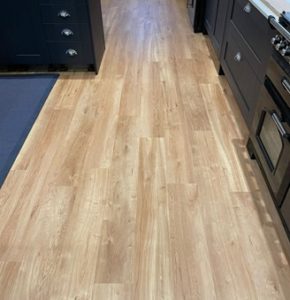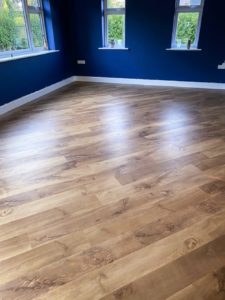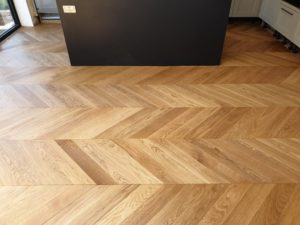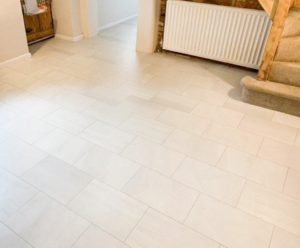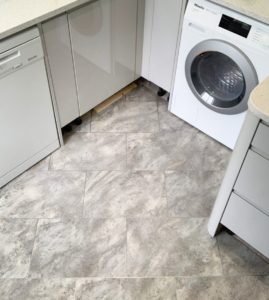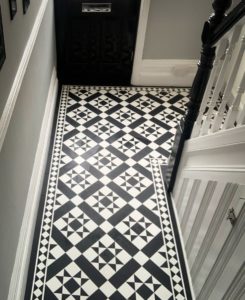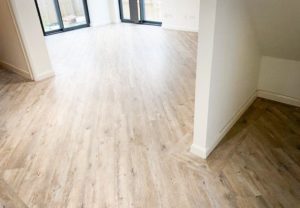One of the things that keeps us loving what we do is the variety in our work. Every room, in every home or workspace is different which means that the choice of pattern for floor laying in each space is something that should be considered to best complement the room. So, we thought it might be useful to run through a few of the most popular laying patterns and the benefits that they can bring to a room.
Classic Straight Lay
Ever popular and arguably the most traditional of laying styles is a standard linear design. This pattern offers a timeless and stylish look. Usually this is along the length of the longest side of a room, although there is a school of thought that the laying direction should be the direction of the source of light in the room. These two directions are often the same in a room, but if they are not for your room, then you may wish to consider which element you most wish to emphasise. And of course, if your room is square in proportions then considering the direction of light in your room, may help guide your decision.
Straight lay designs tend to recede visually, allowing other design elements in the room to take centre stage. So, if you have furniture that you wish to see shine, then this may be the laying pattern for you.
With long planks there are broadly three types of laying pattern, brick lay, staggered and random. Whilst brick lay works well for broader ceramic or stone tiles, it can be optically distracting with long wooden planks. The join lines can become the dominant visual feature, rather than letting the features of the wood design itself be the focus. The same can be said of any other regular staggered laying pattern. Therefore, our preference is for a random layout which allows the grain and detail of the wood to do the talking.
45 Degree Lay
Choosing to lay your planks at a 45 degree angle can really open up a room. This makes the design great for a smaller space. Diagonally laid planks are also great for hiding wonky walls. There is of course more cutting and trimming involved, which can use slightly more material, but it really is a great way of tricking the eye into making a room feel more expansive.
Herringbone – Large or Small
Historically a herringbone pattern has been laid using small parquet tiles, which adds interest to a floor. However, more recently laying large planks in a herringbone design has become a big trend.
Herringbone laid floors, small or large, have the ends of planks overlapping at a 90 degree angle to create an intricate design, which leads the eye across the floor. These designs purposefully make a feature of the join lines between planks, unlike the straight lay designs above.
If you are wanting your floor to be a design feature in its own right, then opting for a herringbone design, could be the solution for you. Deciding between a small or large plank design will depend on the size of your space and how much detail you want to display. In a hallway where there may not be much furniture, a design using the smaller parquet tiles can provide visual interest where otherwise it might be lacking. In large spaces, a small tile can look very “busy”, meaning that a larger plank herringbone design might be more appropriate.
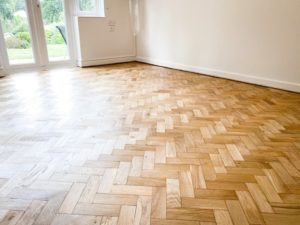
Chevron Style
Chevron laid floors are often confused with herringbone designs. But as you can see from these pictures, a chevron floor is in fact quite different. The ends of the planks are mitre cut and butted up against one another, rather than overlapped. This design offers a more modern take on the traditional parquet floor, although the roots of the style are also quite traditional. It offers cleaner lines, whilst maintaining a lot of the visual interest offered by a herringbone design.
Although commonly fitted using small parquet type tiles, this design can also be achieved with large planks. The same considerations for what size to use are relevant for chevron designs as for herringbone patterns.
Not looking at a wood floor?
Many of the same concerns apply to the laying patterns of non-wood floors as those we have discussed above. However, due to the shape of ceramic or stone designed tiles, some of our recommendations for these tiles are quite different. For example, a brick lay designs can look very attractive on a stone or ceramic style floor, where the join lines become a fabulous feature of the floor.
Using the 45 degree trick and laying tiles on the diagonal is often forgotten about, but can be hugely effective in making a space feel larger.
And then there are other intricate designs available to add interest to spaces which simply aren’t available in wood. Much like the consideration of using a smaller parquet tile, a design like this is an excellent option for spaces where your floor is going to be the main feature of the room.
To Border or Not To Border?
One last thing to think about when choosing your floor design, is whether to include a boarder. If your space is small, it can make it feel smaller, so that is definitely something to bear in mind. However, for nearly all designs (straight lay being the notable exception) a border adds a crisp and clean edge to a floor, elevating the stylishness of the floor and offering a sophisticated and well thought out look.

